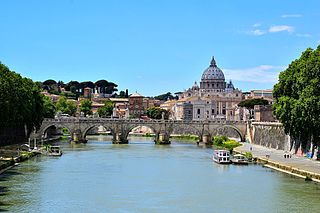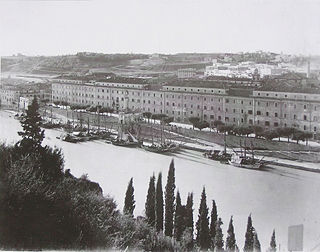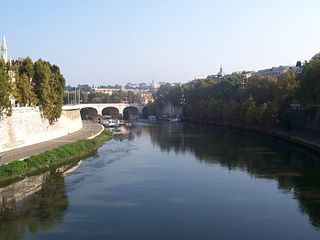
The Tiber is the third-longest river in Italy and the longest in Central Italy, rising in the Apennine Mountains in Emilia-Romagna and flowing 406 km (252 mi) through Tuscany, Umbria, and Lazio, where it is joined by the River Aniene, to the Tyrrhenian Sea, between Ostia and Fiumicino. It drains a basin estimated at 17,375 km2 (6,709 sq mi). The river has achieved lasting fame as the main watercourse of the city of Rome, which was founded on its eastern banks.

Ponte is the 5th rione of Rome, Italy, identified by the initials R. V, and is located in Municipio I. Its name comes from Ponte Sant'Angelo, which connects Ponte with the rione of Borgo. This bridge was built by Emperor Hadrian in 134 AD to connect his mausoleum to the rest of the city. Though Pope Sixtus V changed the rione limits, so that the bridge belongs now to Borgo, not to Ponte anymore, the area has kept its name and a bridge as its coat of arms.

Prati is the 22nd rione of Rome, Italy, identified by the initials R. XXII. It belongs to the Municipio I since 2013, while previously, along with Borgo and quartieri Trionfale and Della Vittoria, it was part of the Municipio XVII.

Campo Marzio is the 4th rione of Rome, Italy, identified by the initials R. IV. It belongs to the Municipio I and covers a smaller section of the area of the ancient Campus Martius. The logo of this rione is a silver crescent on a blue background.

Ponte Sant'Angelo, originally the Aelian Bridge or Pons Aelius, is a Roman bridge in Rome, Italy, completed in 134 AD by Roman Emperor Hadrian, to span the Tiber from the city centre to his newly constructed mausoleum, now the towering Castel Sant'Angelo. The bridge is faced with travertine marble and spans the Tiber with five arches, three of which are Roman; it was approached by means of a ramp from the river. The bridge is now solely pedestrian and provides a scenic view of Castel Sant'Angelo. It links the rioni of Ponte, and Borgo, to which the bridge administratively belongs.

Alessandro Specchi was an Italian architect and engraver.

Palazzo Borghese is a palace in Rome, Italy, the main seat of the Borghese family. It was nicknamed il Cembalo due to its unusual trapezoidal groundplan; its narrowest facade faces the River Tiber. The entrance at the opposite end of the building, the "keyboard" of the cembalo, faces onto the Fontanella di Borghese, with another in a great flanking facade to the Piazza Borghese that is extended by a slightly angled facade leading down Via Borghese towards the river. Both these entrances lead into a large courtyard on one side of which is a two level open arcade, with paired Doric and Ionic columns, that frames the garden beyond.

The Palazzo Falconieri is a palace in Rome, Italy formed in the seventeenth century as a result of remodelling by the Baroque architect Francesco Borromini. It is the home of the Hungarian Academy Rome, since its foundation in 1927. It is located between Via Giulia and Lungotevere, with entrances to both; it is near Palazzo Farnese and a few houses down and across Via Giulia from the church of Santa Caterina della Rota in the Rione of Regola. From 1814, it was occupied by cardinal Joseph Fesch, Napoleon's uncle.

Ponte Cavour is a bridge in Rome (Italy), connecting Piazza del Porto di Ripetta to Lungotevere dei Mellini, in the Rioni Campo Marzio and Prati.

The Ospizio di San Michele a Ripa Grande or Ospizio Apostolico di San Michele in Rome is a complex represented by a series of buildings in the south end of the Rione Trastevere, facing the Tiber River and extending from the bank of Ponte Sublicio for nearly 500 meters. It stands across the river from the Rione Ripa and the area known as the Porto di Ripetta, once in the Aventine neighborhood of Rome. The Porto di Ripa Grande was the river port that served those coming up from the Mediterranean port of Ostia. This area was once a main port of Rome. While large seafaring ships could not forge easily up the Tiber river to Rome; smaller boats frequently brought supplies from the coast to the city and offloaded at the Porta.

Lungotevere is an alley or boulevard running along the river Tiber within the city of Rome. The building of the Lungoteveres required the demolition of the former edifices along the river banks and the construction of retaining walls called muraglioni.

Ponte Principe Amedeo Savoia Aosta, also known as Ponte Principe or Ponte PASA after its acronym, is a bridge that links Lungotevere dei Sangallo to Piazza Della Rovere in Rome (Italy), in the Rioni Ponte, Trastevere and Borgo.

Porto di Ripa Grande was the river port of Rome, just downstream the former Pons Sublicius, where the wares, going up and down the Tiber towards the dock of Fiumicino, were handled. The building of the muraglioni has erased its existence and function, just keeping a trace in the toponymy and in the two ramps giving access to the quay of the river.

Ponte Palatino, also known as Ponte Inglese, is a bridge that links Lungotevere Aventino to Lungotevere Ripa in Rome (Italy), in the Rioni Ripa and Trastevere.

Lungotevere Ripa is the stretch of Lungotevere that links Ponte Palatino to the Port of Ripa Grande in Rome (Italy), in the Rione Trastevere.

Lungotevere Marzio is the stretch of lungotevere in Rome, Italy, that connects Piazza di Ponte Umberto I with Piazza del Porto di Ripetta, in the rioni Campo Marzio and Ponte.

Lungotevere Testaccio is the stretch of lungotevere that connects piazza dell'Emporio with Largo Giovanni Battista Marzi, in Rome, in the Rione of the same name.

Lungotevere Arnaldo da Brescia is the stretch of the Lungotevere that connects via Ferdinando di Savoia to ponte Matteotti, in Rome, in rione Campo Marzio and the Flaminio quarter.

Lungotevere Tor di Nona is the stretch of Lungotevere that connects Piazza di Ponte Sant'Angelo to Piazza di Ponte Umberto I in Rome, in the rione Ponte. It was named so following the resolution of the city council of 20 July 1887.

The following outline is provided as an overview of and topical guide to Rome:
























